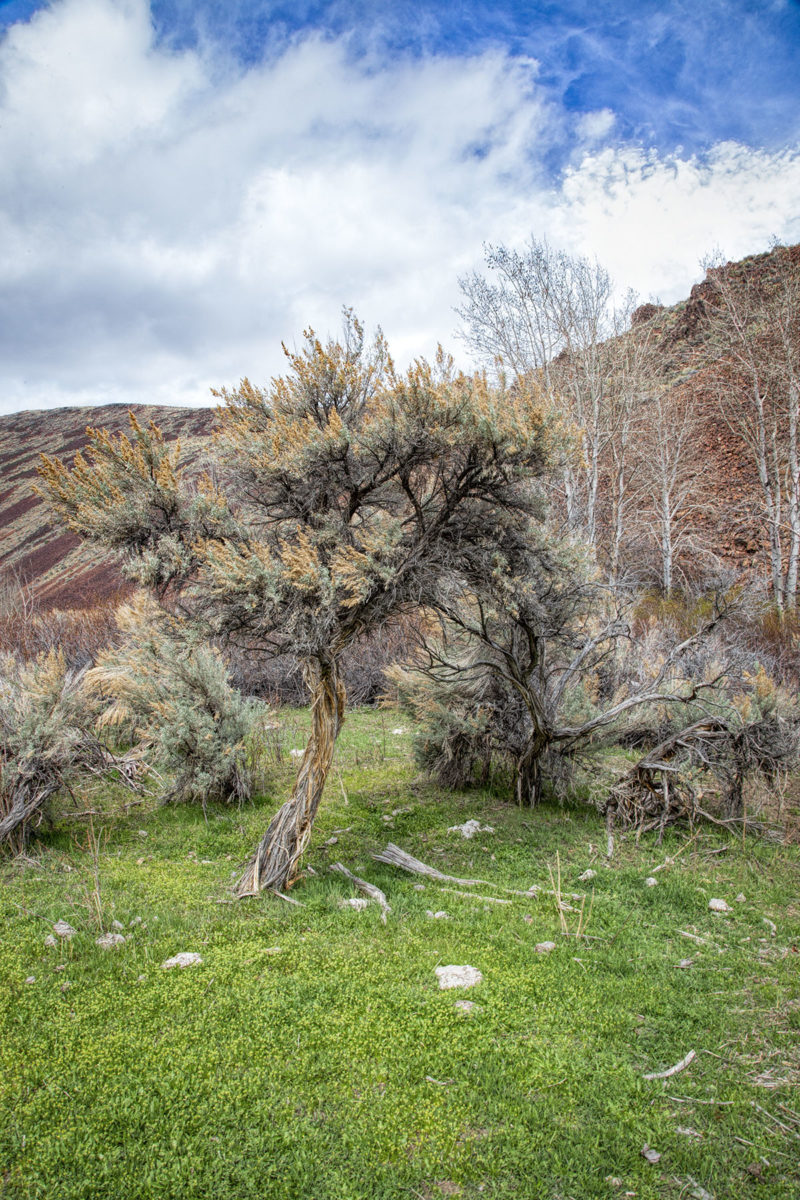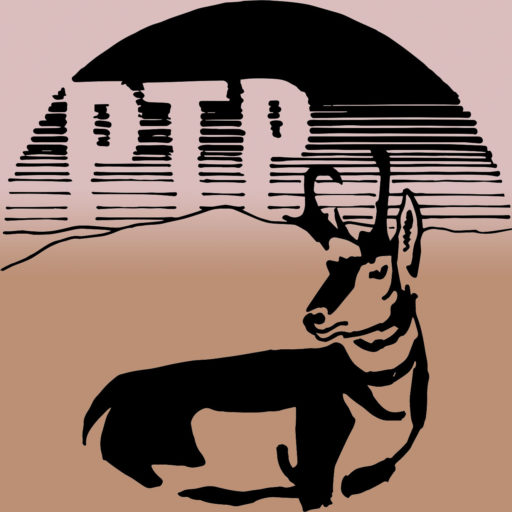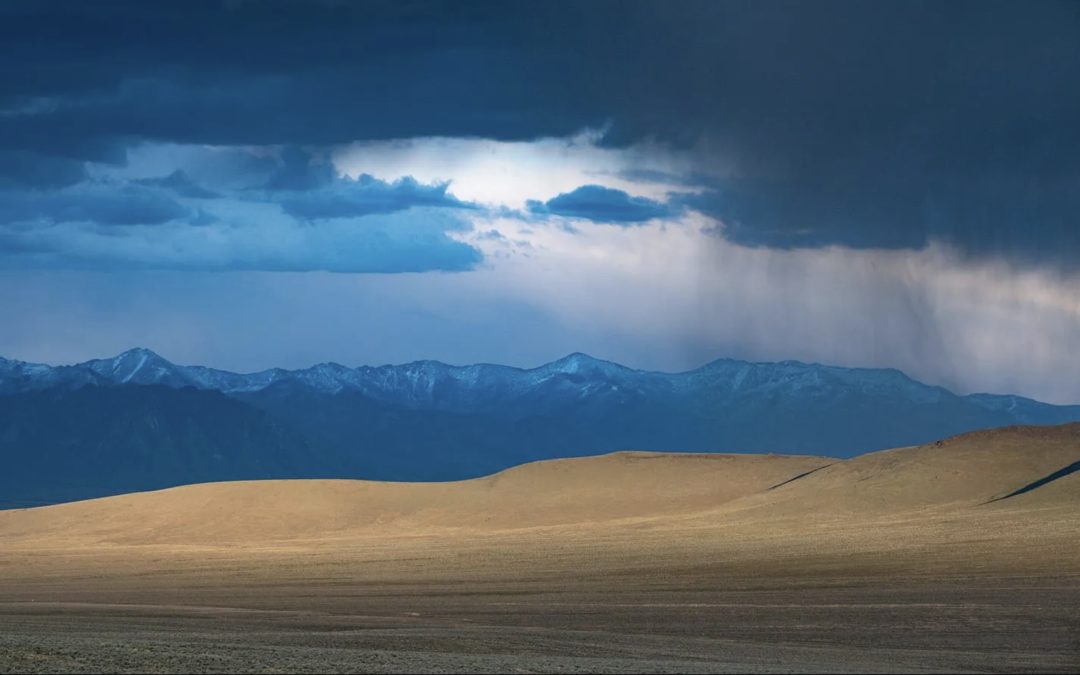To some, the undulating grey and brown fells of the sagebrush sea in the arid American West are dull and boring. Driving at 80mph along the highway, through mile after mile of sagebrush, often with little sign of life except the occasional black cow roasting in the harsh sunlight, the average person sees only a blur of muted colors and landscapes that seem unremarkable at such speed.
But slow down, look closer, and you’ll find land rich with life, almost miraculous life that can survive in the harshest conditions, in areas where temperature swings of 60 degrees between freezing nights and sweltering days are not unusual. Take a turn off the highway in Northern Nevada, and you’ll find a mountain pass shaped like a crescent moon. Stop the car at Peehee Mu’huh, marked on modern maps as Thacker Pass, and take a walk through the waist high sagebrush, discreet yet stunning wildflowers, and tall bunchgrasses. You might come upon a small creek hidden behind the bushes, where spring snails and trout make their home. Smell the sweet perfume of the sage as silvery grey-green leaves brush against your thighs. Visit in early April and just before dawn you might hear the booming of the sage-grouse at their leks as they compete for sagehens’ attentions. Stay for sunrise and you’ll hear the lyrical song of the meadowlark, see the pygmy rabbits awaken, and feel a sage lizard skitter across your toes. Spend a night under the stars and you’ll hear coyotes and owls serenading the Milky Way shining above you. Lie down in fields of wild mustard and garlic and you might recognize the foods traditionally gathered by Native Americans for generations, the wild gardens of the indigenous people who live nearby.
All of this, you could have experienced yourself at Thacker Pass until June 2023. Now, you can experience this only in your imagination.
A history of exploitation
Those who don’t stop long enough to notice the beauty and bounty of these lands in Nevada see only resources to exploit. Miners, ranchers, gamblers, and warmongers have all taken from this land, and then taken more. Men with the glints of gold and silver in their eyes have long looked at these lands and wanted nothing more than to dig them up. Cattle graze in the blistering heat, finding no shade, destroying delicate soil crusts with their heavy hooves, eroding the banks of precious streams and contaminating previously clear water. Cities that suck great gobs of water and electricity from a once wild and now tamed river shine artificially, reflecting sunlight during the day and vitiating the stars at night. Large swathes of the state are radioactive from decades of nuclear tests, and cratered with holes from Air Force bomb tests. The recent history of this land is one of continuous exploitation.
The U.S. General Mining Law was signed in 1872 by Ulysses S. Grant and still governs mining on federal lands, giving preference to mining over all other land uses. Anyone has the right to stake a mining claim on U.S. public land. A corporation that wants to mine just has to prove valuable, extractable deposits exist. Once that’s done, the corporation can mine these deposits for $5 an acre, and pay no royalties at all. It is essentially a mining free-for-all on U.S. public land, and Nevada has a lot of public land.
In the old days, gold and silver were what drew miners to Nevada. These days, the draw is “critical materials” to — as the Biden administration says — ensure a reliable materials supply chain for the clean energy economy and national defense. Since about 2010 or so, developing “critical minerals and materials” has become a driving force in policy [1]. By 2010, China had established itself as the primary source of metals and other materials, including rare earth elements, for global industry [2], and the Obama, Trump, and Biden administrations all realized that depending on China as the major or even sole supplier for these critical materials was not good policy for a whole host of reasons. Most recently, the Biden administration has addressed this concern by encouraging a domestic supply chain for “critical materials” in multiple policies, passing the Infrastructure Investment Act in 2021 [3], invoking the Defense Production Act in April 2022 [4, 5], and passing the Inflation Reduction Act in August 2022 [6], all of which incentivize the development of “critical materials” and discuss at length the importance of these materials for “clean technologies” and national security. To address mining companies’ concerns that the permitting process, including public input periods, for critical materials projects is too lengthy and financially risky, the administration established the Interagency Working Group on Mining Reform in February 2022 [7].
The new “white gold”
One of the many companies benefiting from these policy incentives is Canadian company Lithium Americas Corporation (LAC), and its subsidiary Lithium Nevada Corporation (LNC). By the early 2010’s, LNC (then Western Lithium) had established a lithium claim at Thacker Pass. This claim has now been developed into the Thacker Pass Lithium Mine Project [8] and approved by the Trump administration on January 15, 2021 [9].
The mine project will completely destroy Thacker Pass. The first phases of the project are obliterating about 6,000 acres of land, with a massive open pit, several waste rock and tailings piles, refineries, a processing plant, roads, and other infrastructure. Future expansion plans could triple the mine size to over 17,000 acres encompassing most of the pass. One hundred or more diesel truck trips per day will bring materials and supplies to the mine, including molten sulfur from oil refineries. This sulfur will be refined into sulfuric acid, which will be used to leach lithium from the clay dug from the mine pit.
Until mine construction began in earnest on March 6, 2023, you could sit on a bluff looking out over Thacker Pass, the Montana Mountains, the Double H Mountains, and iconic Sentinel Rock, and hear only the wind, the birds, and the rustling of small creatures in the sagebrush. You could crawl up to the sage-grouse lek at first light, snow softly falling on your face, and hear nothing but the mating calls of these endangered birds. You could dip your toes in Pole Creek, and listen to the tinkling water, water seeping from snow and ground several miles up the canyon, knowing all the plants and animals of Thacker Pass needed that clean, clear water for life.
Now, all you will hear is machinery, 24/7, 365 days a year. Once the mine infrastructure is completed and extraction begins, there will be no respite from industrial noise, industrial destruction, and industrial pollution. The sage-grouse who need large areas of absolute quiet to mate and raise their families will flee, along with many other birds and animals. The delicate soil crusts will be destroyed, along with the sagebrush and wildflowers and grasses and all who depend on these plants for life. 1.85 billion gallons of water will be pulled from the ground every year to supply this mine in the most arid state in the United States. Perhaps Pole Creek will be no more, or will be contaminated by toxins from mining waste.
Mining companies are greenwashing
Lithium Nevada has the audacity to call this mine “green”. How? Because the lithium they extract from the clay beneath the soil will be used to build electric car batteries. “Green mining” is a relatively new concept, and one that mining companies are eagerly employing incentivized by U.S. policies encouraging “critical materials” for “clean energy technologies”. There are several ways a mining company can claim its project is “green” [10]: it uses methods to save energy and/or water in mining processes; it ensures availability of “critical materials” for building “clean technologies” (e.g. electronic vehicles, batteries, solar and wind technologies, etc.); it improves work and organizational practices; it has a plan for “remediating” the land after mine closure; and it has purchased “offsets” for some impacts caused by the mine, such as habitat loss or biodiversity loss [11].
Lithium Nevada checks several of these boxes: it is recycling water for use in the sulfuric acid refineries; it is supplying lithium for electric vehicle and grid storage batteries; it has ensured a “social license to operate” by bribing the local community with promises of jobs, and a new community centre with daycare, preschool, playground, cultural centre, and communal greenhouse; it has set aside $47 million in financial assurance to “guarantee revitalization of the site” after the mine closes; and it has purchased sage-grouse habitat offsets, money paid to protect sage-grouse habitat elsewhere.
However, none of these checkboxes mean much in the real world once the land has been destroyed and polluted, and the ground has been sucked dry of water. What use is a job if you can’t find water to drink or safely breathe the air where you live? What use is a new community center once the mine closes, the jobs go away, and the land has been polluted so ranching and farming are no longer viable alternatives for employment? What use is lithium for car batteries when it is the proliferation of cars and the lifestyles they enable that are helping to destroy the planet? What use is “revitalizing” Thacker Pass when all the plants and animals are dead and gone? What use is sage-grouse habitat elsewhere to the sage-grouse who call Thacker Pass home, and now have nowhere else to go (since sage-grouse habitat elsewhere is already inhabited by sage-grouse there)?
Building a materials-intensive energy system
As the cries of “climate emergency!” get ever more strident and political elites are ever more desperate to keep this ecocidal way of life going — that is, business as usual — more people are suddenly realizing that replacing a fossil fuel-intensive energy system with a materials-intensive energy system will require a whole lot of of materials. “Critical materials” as we now must call them. Our modern lives have always depended on materials — that is not new — and getting those materials has always required mining and extraction, which destroys the land in the process. What is now new is the energy piece: not only do we need materials to build our houses and our cars and our appliances and our factories and our machines, now we need materials to build the machines to generate the energy we use to extract the materials, refine the materials, manufacture more machines and other things out of those materials, and ship all of this to us, all around the world. “Machines making machines making machines” as John Weber described it in a blog post about how solar panels are made [12].
Most of all, a materials-intensive energy system built on top of an already materials-intensive way of life for the 8 billion people on the planet means more mining than anyone can possibly imagine. Researcher Simon Michaux has recently calculated that to make one generation of machines that can generate enough electricity to replace fossil fuels will require more of some materials than we know exist on Earth. As just one example, global reserves of lithium (2022) are 22,000,000 tons; to produce one generation of technology units to phase out fossil fuels will require 944,150,293 tons of lithium [13]. That’s 43 times the amount of lithium in known reserves. And that’s just for the first generation of machines — “technology units” in Michaux’s parlance. These machines don’t last forever. Car batteries last 10 years, and solar panels and wind turbines last 20–30 years. While some materials can be recycled, materials are always lost in the recycling process, which is energy intensive and highly polluting, so new materials are always required. The idea that we can keep making these machines again and again, while continuing to grow the economy (“business as usual”) is pure fantasy.
Will mining be the greatest threat to the land?
Phase 1 construction of the Thacker Pass mine is underway. The Protect Thacker Pass campaign [14] managed to delay the mine for two years by occupying the site, working with tribes to sue the corporation and the Bureau of Land Management (the federal agency that manages public lands in the U.S.), and with consistent and hard-hitting media campaigns. We will not stop fighting the Thacker Pass mine project; we failed to stop Phase 1, but we will try to stop Phase 2; if we can’t stop that, we will try to stop future expansions; and so on. We have even more work to do — while there is just one lithium mine currently operating in Nevada as of mid-2023, there are thousands of lithium claims around the state and several mining projects in development. All of these mines threaten the land and the species who depend on that land for life.
Lithium is in high demand around the world. Chile, Bolivia, Argentina, and Australia supply much of the world’s lithium right now, with more lithium mines planned not just in Nevada, but California, Maine, and North Carolina, as well as countries like the UK and Portugal. Many affected communities are mounting passionate grass-roots resistance to lithium mining [15].
Of course, lithium isn’t the only critical mineral on the list. Helpfully, the Inflation Reduction Act lists all 31 minerals it deems are “critical.” Along with these critical minerals are the minerals modern industry relies on (minerals not listed as critical because they already have well-developed supply chains in the U.S.) including minerals like iron ore (used to make steel), nickel (used to make steel and batteries), copper (used in all things electronic), uranium (used in “clean energy” nuclear power plants), and more. All of these minerals, too, are in high demand as industry and technology continue to grow.
As the world proceeds in its attempt to develop a materials-intensive energy system — “clean energy technologies” — you can be assured there will be a mine coming soon to the land you love [16]. The sheer scale of materials required for this technology-centered future — the fourth industrial revolution, as the World Economic Forum calls it [17, 18] — demands it. Will we muster the resistance to protect the land? Is there any work more important than that?

The only green that matters
Ultimately, none of this is “green”, not in the real sense of green, the sense that we the people who care about the land mean it. Mining companies and technology companies have perverted the true meaning of green to manufacture consent so they can continue destroying the land. For us land lovers, green means life. Green means healthy forests and thriving natural communities, not cutting trees so corporations can extract ore from rock; it means building new soil the slow, natural way, not strip mining it away and poisoning it for extraction. Green means clear rivers and healthy fish; old-growth sagebrush and birdsong so loud and intense we are overwhelmed with joy. Green means saving and restoring habitats, not turning them into “offsets” for mining projects; it means creating real jobs working the land in truly sustainable ways, not jobs destroying the land for temporary profits. Our green, the one that means our loyalty to land and life, is the only green that matters.
References
[1] https://www.govinfo.gov/content/pkg/CHRG-112shrg70660/html/CHRG-112shrg70660.htm
[2] https://www.govinfo.gov/content/pkg/CHRG-113shrg86877/html/CHRG-113shrg86877.htm
[3] https://www.congress.gov/bill/117th-congress/house-bill/3684/text
[5] https://crsreports.congress.gov/product/pdf/R/R47124
[6] https://www.congress.gov/bill/117th-congress/house-bill/5376/text
[10] Mineral Deposits of Finland, Maier et al., 2015
[11] Green Grabbing: A New Appropriation of Nature, Fairhead et al., 2013
[12] http://sunweber.blogspot.com/2011/12/machines-making-machines-making.html
[13] https://www.youtube.com/watch?v=MBVmnKuBocc
[14] https://protectthackerpass.org
[17] https://www.weforum.org/focus/fourth-industrial-revolution
[18] https://www.weforum.org/agenda/2023/01/minerals-metals-energy-transition-davos2023/
Images
Thacker Pass, by Max Wilbert
Old-growth sagebrush at Thacker Pass, by Elisabeth Robson


Recent Comments